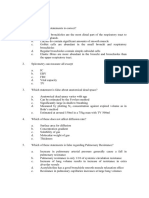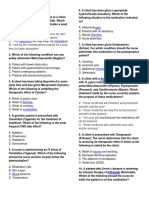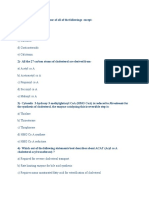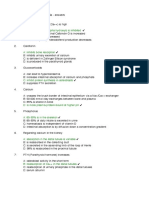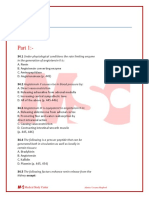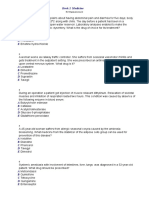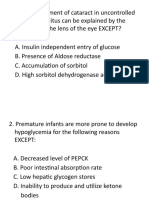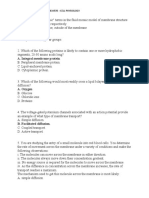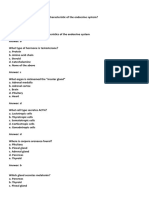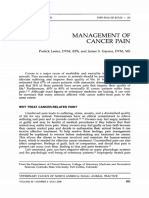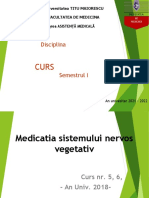Anticoagulant Mcqs Explained
Anticoagulant Mcqs Explained
Uploaded by
Hawi BefekaduCopyright:
Available Formats
Anticoagulant Mcqs Explained
Anticoagulant Mcqs Explained
Uploaded by
Hawi BefekaduOriginal Description:
Original Title
Copyright
Available Formats
Share this document
Did you find this document useful?
Is this content inappropriate?
Copyright:
Available Formats
Anticoagulant Mcqs Explained
Anticoagulant Mcqs Explained
Uploaded by
Hawi BefekaduCopyright:
Available Formats
Anticoagulants
1. Warfarin
a. Blocks the gamma-carboxylation of glutamate residues in Protein C <=
b. Has poor oral bioavailability
c. Does not cross the placenta
d. Anticoagulant activity is reduced by amiodarone
e. Inactivates activated factors II, VII, IX, X
2. Which is correct regarding warfarin?
a. Broken down in GIT
b. Added to transfused blood
c. Decreases thromboplastins
d. ?
e. ?
3. Which drug does not interact with warfarin?
a. Phenobarbitone – inducer, thus decrease
b. Loop diuretics – pharmacodynamic decrease
c. Benzodiazepines <=
d. Cephalosporins – 3rd gen, kill vit K producing bacteria so increase
e. ?
4. Regarding fibrinolytics
a. Urokinase is cheap but less selective
b. Streptokinase comes from human cells
c. HIMA says GIT haemorrhage is most common haemorrhagic complication
d. GIT haemorrhage within 12 months is a contraindication
e. Actriylitic acid is a potent fibrinolytic inhibitor
5. Ticlodipine
a. Decreases platelet aggregation by inhibiting ADP pathway of platelets <= also clopidogrel
b. Has no GIT side effects – commonSE, less w/ clopidogrel
c. Inhibits prostaglandin metabolism – unlike aspirin, no effect
d. ?
e. ?
6. Heparin
a. Inhibits antithrombin III
b. Causes alopecia <=
c. Decreases rate of conversion of prothrombin to thrombin – increases the inactivation of 2
(thrombin), 9 and 10 (10 only for LMWH)
d. Decreases rate of conversion of fibrinogen to fibrin
e. Decreases rate of conversion of VII to VIIa
7. Heparin induced mild thrombocytopenia is caused by
a. Release of lipoprotein lipase
b. Aggregation <= ?
c. Thrombosis
d. Antiplatelt antibodies
e. None of the above
8. Which is NOT true of warfarin?
a. It has a half life of 6 hours <= 36
b. It is reversed by FFP
c. It is 99% protein bound
d. It affects vitamin K synthesis
e. It is 100% bioavailable
9. Which drugs increase the INR?
a. Benzodiazepines
b. Barbiturates
c. Rifampin
d. Cholestyramine
e. Amiodarone <=
10. Regarding fibrinolytics
a. All thrombolytics act to convert free plasminogen to plasmin – tPA works on bound
b. Urokinase is a human product <= from kidneys
c. tPA and APSAC lack the streptococcal antigen
d. Reactions to tPA and anistreplase are preparation related
e. tPA does not occur naturally
11. Regarding heparin
a. Does reduction is necessary in the elderly
b. LMW fractions have more effect on thrombin than HMW
c. It may cause alopecia <=
d. It inhibits antithrombin III
e. Protamine is a competitive antagonist of heparin
12. Warfarin
a. Is an orally administered anticoagulant with low bioavailability
b. Blocks the alpha carboxylation of glutamate residues in protein C
c. Has an anticoagulant action which is immediate
d. Does not cross the placenta-blood barrier
e. Causes decreased prothrombin time when given with diuretics <=
13. Heparin
a. Consists of a heterogenous group of glycoprotein’s - mucopolysaccharides
b. Acts by decreasing activity of blood coagulant factor VII
c. Is associated with osteomalacia
d. Increases the reaction rate of antithrombin III on clotting factors <=
e. Is consumed in anticoagulation activity
14. Low molecular weight heparins
a. Have a higher affinity for antithrombin than high molecular weight heparin
b. Are less effective in preventing the development of deep venous thrombosis
c. Have a higher bioavailability from the subcutaneous site of injection than normal heparin <=
d. Require more frequent dosing than normal heparin
e. Level monitoring may be required in liver failure – renal and pregancy
15. regarding streptokinase
a. the GUSTO trial showed a higher risk of haemorrhagic stroke compared to t-PA
b. it is administered intravenously as a single rapid bolus dose
c. it converts plasmin to plasminogen
d. there are no in vivo inhibitors for the streptokinase-proactivation complex <=
e. urokinase is made by bacteria
16. Warfarin
a. Is not bound to plasma proteins
b. Is poorly absorbed orally
c. Is mainly excreted by the kidney
d. Is metabolized by the liver <=
e. Does not cross the placenta
17. With regard to heparin
a. High molecular weight heparin acts primarily by activating antithrombin III <=
b. Protamine fully reverses the effects of low molecular weight heparins
c. Protamine inactivates heparin by enzymatically degrading the heparin molecule
d. Low molecular weight heparin has a high affinity for factor XII - X
e. Heparin is reliably absorbed after oral administration
18. streptokinase
a. is a complex lipopolysaccharide
b. is synthesized by the human kidney
c. binds to the proactivator plasminogen <=
d. activates the plasminogen that is bound to fibrin
e. is more dangerous than tPA in those over 75 years of age
19. all of the following are known to potentiate the effects of oral anticoagulants EXCEPT:
a. cimetidine
b. ceftriaxone
c. rifampicin <=
d. metronidazole
e. trimethoprim
20. Regarding fibrinolytics
a. TIMI trial showed increased incidence of GI bleed as the major side effect of administration
b. Aminocaproic acid inhibits fibrinolysis <=
c. ?
d. ?
e. ?
21. Which of the following drugs can cause alopecia
a. Warfarin
b. Heparin <=
c. Verapamil
d. Ticlodipine
e. Digoxin
You might also like
- Pediatric Drugs MKDDocument3 pagesPediatric Drugs MKDquixoticdreamer100% (7)
- MBBS Pathology MCQsDocument4 pagesMBBS Pathology MCQsDoctorAlan John Naveen Chandar100% (3)
- MCQ Bleeding Disorders 2nd Year2021Document6 pagesMCQ Bleeding Disorders 2nd Year2021sherif mamdoohNo ratings yet
- Pharm Cvs McqsDocument30 pagesPharm Cvs McqsSoodn Kang Soodn100% (3)
- 2001 Pharmacology McqsDocument10 pages2001 Pharmacology McqsKenneth MiguelNo ratings yet
- 2. Final Autumn 2017 (1خت فت) (PH343)Document15 pages2. Final Autumn 2017 (1خت فت) (PH343)Alaa MohammedNo ratings yet
- Antibiotic Mcqs June 04Document6 pagesAntibiotic Mcqs June 04Mirza GhalibNo ratings yet
- All Other NZ McqsDocument36 pagesAll Other NZ McqsTran Thai SonNo ratings yet
- Pharma McqsDocument45 pagesPharma McqsFarah IqbalNo ratings yet
- ElectrolytesDocument6 pagesElectrolytesOsama AlhumisiNo ratings yet
- Pathology Cell InjuryDocument2 pagesPathology Cell Injuryv_vijayakanth7656100% (1)
- Year 3 Undergraduate Progressive Test - Attempt reviewPDF - 231031 - 194511Document49 pagesYear 3 Undergraduate Progressive Test - Attempt reviewPDF - 231031 - 194511DR BUYINZA TITUSNo ratings yet
- Web Path AllDocument116 pagesWeb Path AllFYM0% (1)
- Pharm Resp Mcqs PDFDocument8 pagesPharm Resp Mcqs PDFVikashgtm100% (1)
- Krok 1 - 2015 (Anatomy)Document29 pagesKrok 1 - 2015 (Anatomy)mayna ynaNo ratings yet
- MCQs & ANS (4) - 99-102Document5 pagesMCQs & ANS (4) - 99-102Hawraa AdilNo ratings yet
- Pharmacy Links 2Document2 pagesPharmacy Links 2Bosch Pharmaceuticals50% (2)
- Fluids and Electrolytes MCQ S LJDocument5 pagesFluids and Electrolytes MCQ S LJVicviclookThekingNo ratings yet
- 2014 Internal COC PharmaDocument16 pages2014 Internal COC PharmategenezewudeNo ratings yet
- COMMON MCQ Endo 2017 PDFDocument27 pagesCOMMON MCQ Endo 2017 PDFعلي. احمدNo ratings yet
- Skeletal Muscle Relaxants MCQsDocument22 pagesSkeletal Muscle Relaxants MCQsMeghana PatilNo ratings yet
- Pathology Exam Committee VDocument7 pagesPathology Exam Committee VErsin TukenmezNo ratings yet
- 200+ Correct Solved BCQS Pharmacology 6th Semester MBBS LUMHSDocument61 pages200+ Correct Solved BCQS Pharmacology 6th Semester MBBS LUMHSSaqib MustafaNo ratings yet
- Examination Number .......... NACTE Registration NumberDocument12 pagesExamination Number .......... NACTE Registration NumberNithish DevadigaNo ratings yet
- Class Notes On Questionnaires For Pharmacology in The Gastrointestinal TractDocument12 pagesClass Notes On Questionnaires For Pharmacology in The Gastrointestinal TractMarqxczNo ratings yet
- Pharmacology of Cardiovascular Diseases - MCQDocument1 pagePharmacology of Cardiovascular Diseases - MCQHawi BefekaduNo ratings yet
- MCQ PharmacologyDocument278 pagesMCQ PharmacologyNader Almaswary0% (1)
- Multiple Choice Questions On ToxicologyDocument2 pagesMultiple Choice Questions On ToxicologyquimicosorioNo ratings yet
- Pharmacology Nursing Questions AntifungalDocument14 pagesPharmacology Nursing Questions AntifungalNWH Adams LabNo ratings yet
- Pharma McqsDocument20 pagesPharma McqsbeulaholuwabunkunfunmiNo ratings yet
- En-Metabolism LipidicDocument25 pagesEn-Metabolism LipidicCristina THCSNo ratings yet
- Physiology Calcium Metabolism MCQ AnswersDocument2 pagesPhysiology Calcium Metabolism MCQ AnswersFor ChristNo ratings yet
- MCQs On CVS Pharmacology by Medical Study CenterDocument47 pagesMCQs On CVS Pharmacology by Medical Study CenterLin YunNo ratings yet
- MCQs InfectionsDocument6 pagesMCQs InfectionsNaeem NawazNo ratings yet
- Test 3 BDSDocument16 pagesTest 3 BDSrababNo ratings yet
- CVS Irfan HabibDocument6 pagesCVS Irfan HabibPardeep Dhurgesh Nkh RatananiNo ratings yet
- PharmacologyDocument25 pagesPharmacologygregNo ratings yet
- Past Papers For Anatomy GISDocument23 pagesPast Papers For Anatomy GISMohammad DarkhabaniNo ratings yet
- Pharmacology McqsDocument7 pagesPharmacology McqsAshraf AboNo ratings yet
- Antibiotics MCQsDocument4 pagesAntibiotics MCQsPh Israa Kadhim100% (1)
- Spleen MCQDocument22 pagesSpleen MCQShriyansh Chahar0% (1)
- Pharma MCQS PointsDocument9 pagesPharma MCQS PointsNajeeb Ullah Qadir via GTXNo ratings yet
- General Pharmacology MCQs (Edited)Document47 pagesGeneral Pharmacology MCQs (Edited)M7md AllahhamNo ratings yet
- Biochemistry and Medicine InfographicDocument5 pagesBiochemistry and Medicine InfographicScribdTranslationsNo ratings yet
- Carbohydrate Metabolism - MCQs 4 BDocument10 pagesCarbohydrate Metabolism - MCQs 4 BSaroja Veeresh100% (1)
- C. Common Cardinal VeinsDocument6 pagesC. Common Cardinal VeinsTofik MohammedNo ratings yet
- Pulmonary TB MCQSDocument4 pagesPulmonary TB MCQSAbid SunhanNo ratings yet
- Review Mcqs For 2016 Systemic PathologyDocument8 pagesReview Mcqs For 2016 Systemic PathologySameer100% (1)
- Cell Physiology Revision QuestionsDocument6 pagesCell Physiology Revision QuestionsjoojoNo ratings yet
- MCQ PharmacokineticsDocument10 pagesMCQ PharmacokineticsHarshit Sharma100% (1)
- Endocrine SystemDocument12 pagesEndocrine System4ul9No ratings yet
- Biochemistry MCQS - VitaminsDocument3 pagesBiochemistry MCQS - VitaminsRati PotateNo ratings yet
- University of Hargeisa GIT Pharmacology Review Questions: Name:aniisa Muse Ahmed Faculty:midwifery ID:1716642 Class:3ADocument4 pagesUniversity of Hargeisa GIT Pharmacology Review Questions: Name:aniisa Muse Ahmed Faculty:midwifery ID:1716642 Class:3AAniza Mouse100% (1)
- MCI Screening Test 2005Document46 pagesMCI Screening Test 2005Iboyaima SinghNo ratings yet
- Multiple Choice Questions-Acid Base BalanceDocument6 pagesMultiple Choice Questions-Acid Base BalanceFarryrazaNo ratings yet
- Pharmacology MCQs 26512Document63 pagesPharmacology MCQs 26512Faiz RehmanNo ratings yet
- Blood MCQDocument6 pagesBlood MCQtarekhk05No ratings yet
- Pharmacokinetics / Pharmacodynamics Mcqs May 2006Document36 pagesPharmacokinetics / Pharmacodynamics Mcqs May 2006Mishu100% (1)
- Heart Failure Mcqs ExplainedDocument2 pagesHeart Failure Mcqs ExplainedHawi Befekadu100% (1)
- Diuretics Mcqs ExplainedDocument2 pagesDiuretics Mcqs ExplainedHawi BefekaduNo ratings yet
- Antihypertensive Mcqs ExplainedDocument4 pagesAntihypertensive Mcqs ExplainedHawi BefekaduNo ratings yet
- Pharmacology of Cardiovascular Diseases - MCQDocument1 pagePharmacology of Cardiovascular Diseases - MCQHawi BefekaduNo ratings yet
- Dios Tu Solamente Es Dios AutosavedDocument531 pagesDios Tu Solamente Es Dios AutosavedIan LimNo ratings yet
- 2021 Hawaii Physician Workforce AssessmentDocument44 pages2021 Hawaii Physician Workforce AssessmentHPR NewsNo ratings yet
- Respiratory Medicine: Short CommunicationDocument3 pagesRespiratory Medicine: Short CommunicationFernando SarmientoNo ratings yet
- BASIC PHARMACOKINETICS - CHAPTER 11: Multicompartment ModelDocument65 pagesBASIC PHARMACOKINETICS - CHAPTER 11: Multicompartment ModelDrHeba100% (1)
- Care For Diabetic PatientDocument2 pagesCare For Diabetic PatientRanee Diane Ananayo100% (1)
- Lester, P. Gaynor, J. S. Management of Cancer Pain. Veterinary Clinics of North America Small Animal Practice, v.30, n.4, p.951-966. 2000 PDFDocument16 pagesLester, P. Gaynor, J. S. Management of Cancer Pain. Veterinary Clinics of North America Small Animal Practice, v.30, n.4, p.951-966. 2000 PDFFran WermannNo ratings yet
- Job Satisfaction in Pharma Company With Reference To Andhra OrganicsDocument94 pagesJob Satisfaction in Pharma Company With Reference To Andhra OrganicsRaviNo ratings yet
- PRN Asthma TXDocument29 pagesPRN Asthma TXisauraNo ratings yet
- Stock StatusDocument42 pagesStock Statusprashant singhNo ratings yet
- 2018 Book EndophthalmitisDocument400 pages2018 Book EndophthalmitisHang doNo ratings yet
- 2023 - Mood Disorders Lecture NotesDocument13 pages2023 - Mood Disorders Lecture NotesNEIL NETTE S. REYNALDONo ratings yet
- LP 03-May24lDocument11 pagesLP 03-May24lJosue0820No ratings yet
- 05 - 06 - 07.curs Farmacologie Speciala (SNV)Document108 pages05 - 06 - 07.curs Farmacologie Speciala (SNV)madalinaNo ratings yet
- IRJASH ArticleDocument13 pagesIRJASH Articleade mahdiyyahNo ratings yet
- The Sedated Society: The Causes and Harms of Our Psychiatric Drug Epidemic. ISBN 3319449109, 978-3319449104Document23 pagesThe Sedated Society: The Causes and Harms of Our Psychiatric Drug Epidemic. ISBN 3319449109, 978-3319449104hanaemeete100% (14)
- Adco Contromet - PI - Adcock Ingram - MCC Format03 July 2020Document5 pagesAdco Contromet - PI - Adcock Ingram - MCC Format03 July 2020mogausedibeng116No ratings yet
- Pharmaceutical PowdersDocument72 pagesPharmaceutical Powdersvidyasreedm151No ratings yet
- Pediatric Drugs and Dosages Hammad ArifDocument11 pagesPediatric Drugs and Dosages Hammad ArifHammad Arif100% (1)
- PD2Document15 pagesPD2DrShobhit RajNo ratings yet
- Breast Cancer Care StudyDocument11 pagesBreast Cancer Care StudyMichael Selorm AgomadoNo ratings yet
- Acute Coronary Syndromes: Unstable Angina and Non-ST Elevation Myocardial InfarctionDocument18 pagesAcute Coronary Syndromes: Unstable Angina and Non-ST Elevation Myocardial InfarctionLOZANO GARCIA PAOLA ALEJADRANo ratings yet
- Sun Pharma Announces Positive Topline Results of Confirmatory Phase-3 Clinical Trial For Secieraâ For Treatment of Dry Eye (Company Update)Document4 pagesSun Pharma Announces Positive Topline Results of Confirmatory Phase-3 Clinical Trial For Secieraâ For Treatment of Dry Eye (Company Update)Shyam SunderNo ratings yet
- Daftar Obat KronisDocument4 pagesDaftar Obat KronisNila Permata SariNo ratings yet
- Assessment TAsk - PharmacokineticsDocument2 pagesAssessment TAsk - PharmacokineticsSha ShaNo ratings yet
- Research Article: Qiuyu Wei, Qiuxuan Yang, Qilong Wang, Congyong Sun, Yuan Zhu, Ya Niu, Jiangnan Yu, and Ximing XuDocument9 pagesResearch Article: Qiuyu Wei, Qiuxuan Yang, Qilong Wang, Congyong Sun, Yuan Zhu, Ya Niu, Jiangnan Yu, and Ximing XuHector LeónNo ratings yet
- 1 EssentialsDocument4 pages1 EssentialsJoanna Carla Marmonejo Estorninos-WalkerNo ratings yet
- Insects and Their Chemical Weaponry: New Potential For Drug DiscoveryDocument21 pagesInsects and Their Chemical Weaponry: New Potential For Drug DiscoveryDario MandicNo ratings yet
- Assignment#3 Psychosis Diagnosis & Antipsychotic DrugsDocument5 pagesAssignment#3 Psychosis Diagnosis & Antipsychotic DrugsMuhammad Haris Khan KhattakNo ratings yet
- Isolation and Standardization of Gingerol From Ginger Rhizome by Using TLC, HPLC, and Identification TestsDocument4 pagesIsolation and Standardization of Gingerol From Ginger Rhizome by Using TLC, HPLC, and Identification Testsronahaniifah11No ratings yet














